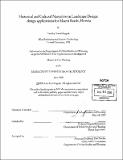Historical and cultural narratives in landscape design : design applications for Miami Beach, Florida
Author(s)
Dzegede, Anyeley Yawa, 1976-
DownloadFull printable version (21.12Mb)
Other Contributors
Massachusetts Institute of Technology. Dept. of Urban Studies and Planning.
Advisor
Dennis Frenchman.
Terms of use
Metadata
Show full item recordAbstract
Narrative landscapes are designed environments that use physical elements, spaces and stories to convey messages and make place. Through the use of narrative landscapes, designers can relate the historical and cultural significance of particular places and peoples. The designer must be concerned not only with the contents of the story, but with the role of the readers, the community and in the ideologies and worldviews these narratives imply. The issues involved with creating narrative in the landscape are in the incorporation of the stories and elements of the past and the use of symbolic and didactic media. In our multicultural and highly mediated society, landscape designs for public places should be pluralistic and multi-dimensional. A pluralistic design conveys the stories of personalities, communities, historic events, and places and is made within a community process or with community input. The multidimensional aspect of narrative designs emanates from the blending of abstracted or symbolic forms of communication and didactic forms that carry a series of messages. Narrative landscapes were examined to determine how designed elements and sequencing tell stories in the landscape. The information gathered was used to develop a potential design approach for the Indian Creek Corridor in Miami Beach, Florida.
Description
Thesis (M.C.P.)--Massachusetts Institute of Technology, Dept. of Urban Studies and Planning, 2000. Includes bibliographical references (p. [94]-[97]).
Date issued
2000Department
Massachusetts Institute of Technology. Department of Urban Studies and PlanningPublisher
Massachusetts Institute of Technology
Keywords
Urban Studies and Planning.